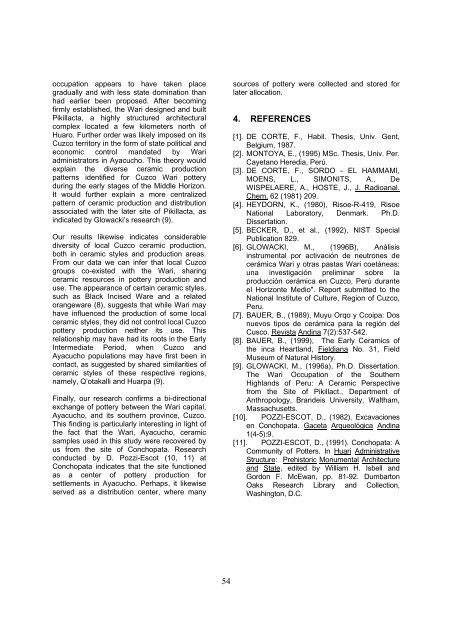Informe Científico Tecnológico del IPEN 1998 - 2001 - Gestion de la ...
Informe Científico Tecnológico del IPEN 1998 - 2001 - Gestion de la ...
Informe Científico Tecnológico del IPEN 1998 - 2001 - Gestion de la ...
Create successful ePaper yourself
Turn your PDF publications into a flip-book with our unique Google optimized e-Paper software.
occupation appears to have taken p<strong>la</strong>ce<br />
gradually and with less state domination than<br />
had earlier been proposed. After becoming<br />
firmly established, the Wari <strong>de</strong>signed and built<br />
Pikil<strong>la</strong>cta, a highly structured architectural<br />
complex located a few kilometers north of<br />
Huaro. Further or<strong>de</strong>r was likely imposed on its<br />
Cuzco territory in the form of state political and<br />
economic control mandated by Wari<br />
administrators in Ayacucho. This theory would<br />
exp<strong>la</strong>in the diverse ceramic production<br />
patterns i<strong>de</strong>ntified for Cuzco Wari pottery<br />
during the early stages of the Middle Horizon.<br />
It would further exp<strong>la</strong>in a more centralized<br />
pattern of ceramic production and distribution<br />
associated with the <strong>la</strong>ter site of Pikil<strong>la</strong>cta, as<br />
indicated by Glowacki’s research (9).<br />
Our results likewise indicates consi<strong>de</strong>rable<br />
diversity of local Cuzco ceramic production,<br />
both in ceramic styles and production areas.<br />
From our data we can infer that local Cuzco<br />
groups co-existed with the Wari, sharing<br />
ceramic resources in pottery production and<br />
use. The appearance of certain ceramic styles,<br />
such as B<strong>la</strong>ck Incised Ware and a re<strong>la</strong>ted<br />
orangeware (8), suggests that while Wari may<br />
have influenced the production of some local<br />
ceramic styles, they did not control local Cuzco<br />
pottery production neither its use. This<br />
re<strong>la</strong>tionship may have had its roots in the Early<br />
Intermediate Period, when Cuzco and<br />
Ayacucho popu<strong>la</strong>tions may have first been in<br />
contact, as suggested by shared simi<strong>la</strong>rities of<br />
ceramic styles of these respective regions,<br />
namely, Q’otakalli and Huarpa (9).<br />
Finally, our research confirms a bi-directional<br />
exchange of pottery between the Wari capital,<br />
Ayacucho, and its southern province, Cuzco.<br />
This finding is particu<strong>la</strong>rly interesting in light of<br />
the fact that the Wari, Ayacucho, ceramic<br />
samples used in this study were recovered by<br />
us from the site of Conchopata. Research<br />
conducted by D. Pozzi-Escot (10, 11) at<br />
Conchopata indicates that the site functioned<br />
as a center of pottery production for<br />
settlements in Ayacucho. Perhaps, it likewise<br />
served as a distribution center, where many<br />
54<br />
sources of pottery were collected and stored for<br />
<strong>la</strong>ter allocation.<br />
4. REFERENCES<br />
[1]. DE CORTE, F., Habil. Thesis, Univ. Gent,<br />
Belgium, 1987.<br />
[2]. MONTOYA, E., (1995) MSc. Thesis, Univ. Per.<br />
Cayetano Heredia, Perú.<br />
[3]. DE CORTE, F., SORDO - EL HAMMAMI,<br />
MOENS, L., SIMONITS, A., De<br />
WISPELAERE, A., HOSTE, J., J. Radioanal.<br />
Chem. 62 (1981) 209.<br />
[4]. HEYDORN, K., (1980), Risoe-R-419, Risoe<br />
National Laboratory, Denmark. Ph.D.<br />
Dissertation.<br />
[5]. BECKER, D., et al., (1992), NIST Special<br />
Publication 829.<br />
[6]. GLOWACKI, M., (1996B), Análisis<br />
instrumental por activación <strong>de</strong> neutrones <strong>de</strong><br />
cerámica Wari y otras pastas Wari coetáneas:<br />
una investigación preliminar sobre <strong>la</strong><br />
producción cerámica en Cuzco, Perú durante<br />
el Horizonte Medio". Report submitted to the<br />
National Institute of Culture, Region of Cuzco,<br />
Peru.<br />
[7]. BAUER, B., (1989), Muyu Orqo y Ccoipa: Dos<br />
nuevos tipos <strong>de</strong> cerámica para <strong>la</strong> región <strong><strong>de</strong>l</strong><br />
Cusco. Revista Andina 7(2):537-542.<br />
[8]. BAUER, B., (1999), The Early Ceramics of<br />
the inca Heart<strong>la</strong>nd, Fieldiana No. 31, Field<br />
Museum of Natural History.<br />
[9]. GLOWACKI, M., (1996a), Ph.D. Dissertation.<br />
The Wari Occupation of the Southern<br />
High<strong>la</strong>nds of Peru: A Ceramic Perspective<br />
from the Site of Pikil<strong>la</strong>ct., Department of<br />
Anthropology, Bran<strong>de</strong>is University, Waltham,<br />
Massachusetts.<br />
[10]. POZZI-ESCOT, D., (1982). Excavaciones<br />
en Conchopata. Gaceta Arqueológica Andina<br />
1(4-5):9.<br />
[11]. POZZI-ESCOT, D., (1991). Conchopata: A<br />
Community of Potters. In Huari Administrative<br />
Structure: Prehistoric Monumental Architecture<br />
and State, edited by William H. Isbell and<br />
Gordon F. McEwan, pp. 81-92. Dumbarton<br />
Oaks Research Library and Collection,<br />
Washington, D.C.


